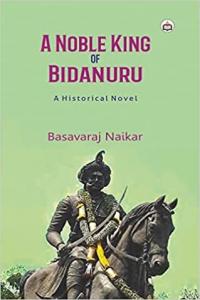Creation and Criticism
ISSN: 2455-9687
(A Quarterly International Peer-reviewed Refereed e-Journal
Devoted to English Language and Literature)
Vol. 07, Joint Issue 26 & 27: July-Oct 2022

Book Review
A Noble King of Bidanuru by Basavaraj Naikar
Basavaraj Naikar. A Noble King of Bidanuru. New Delhi: AuthorsPress, 2022. Pp. 200. Price: 395/-. ASIN: B09Y1J758H
Reviewed by Jagdish Batra
One must remember fondly at times the tales told during childhood by one’s grandma. Mostly, these relate to the cultural epics Ramayana and Mahabharata, but at times, these could relate to other legends as well. The present book A Noble King of Bidanuru by novelist Basavaraj Naikar has some such touch about it. The comparison with the grandmother is not to denigrate it in any sense. In fact, the narrative style is that of a seasoned story-teller, who has a lot of respect for the personality that he is talking about.
The writer Basavaraj Naikar is a professor of English teaching at Karnataka University. A prolific writer, he has published several novels and collections of short stories. His first story collection titled The Thief of Nagarahalli and Other Stories was shortlisted for the Commonwealth Fiction Prize for the year 2000. Besides, his novel The Sun Behind the Clouds which deals with the resistance put up by Naragund king Bhaskararao Bhave against the British rulers during the period of First War of Indian Independence in 1857, attained good popularity. Several of his other novels deal with historical personages – not only kings but saints also. The genre of historical novel has not been popular in India. Mostly it has been restricted to the times of Mughal rule in India, but thanks to authors like Naikar, history of other areas and periods is also being taken up and the genre is now slowly coming into its own.
The noble king about whom his latest novel A Noble King of Bidanuru (2022) talks is Raja Sivappa Nayaka, also called Keladi Sivappa Nayaka, the ruler of the Keladi Nayaka kingdom – successor to the famous Vijayanagar Empire. The reason to select this protagonist is, as the author tells us in Preface, that the history of central Karnataka has not been explored much, and besides, the author’s great grandfather was appointed Dandanayaka in Keladi Kingdom. Raja Nayaka was respected as a wise king and a strong administrator, who loved arts and cared for environment and respected different religions.
The author is an admirer of Raja Sivappa Nayaka. He highlights the way the Portuguese came to the Indian coast to buy spices but they prepared ground to colonize through missionaries. That these wily traders were helped in their nefarious agenda by the internal bickerings of the rulers here is also brought out by the author. The currently debated topic of proselytization is traced back to that period.
King Sivappa Nayaka came to the throne in 1645 AD. During his reign, he defeated the invading Portuguese, wresting from them the coastal forts and bringing under control seaports as far away as Mangalore and Kesargad district of Kerala. He had also to contend with other foreign powers like the Dutch and the British which he did through skillful diplomacy. He is known to have erected a number of forts at various locations. One must concur with the author when he outlines his philosophy which is that “we read history and historical literature not merely for the past-ness of the past, but mainly because of the present-ness of the past.” That gives him adequate rationale to compares the king to our present-day prime minister!
There is no doubt that in order to write a good historical novel, one has to do a lot of research work and employ what we call historical imagination to string various episodes and facts on the basis of logic even as chronology and probability must mould the narrative. The present novel bears the imprint of deep study by the author. He has tried to include a large number of references to culture of central Karnataka reflected in names of people, places or objects, cuisine, dress, rituals, etc.
Naikar has been liberal towards different myths and legends connected with the locale and the life history of Raja Nayaka, and these are given out as simply as the historically true details, just like the grandma did. His generousness also means prolixity which at times appears to result in unnecessary addition of pages. The novel makes an interesting reading, that is, if you like the style of the story-teller of yore. The narrative follows the simple linear narrative format. There are no modern-day stylistic devices like flashback, variations in registers, authorial detachment, etc. The lack of dramatization also differentiates it from the present-day historical fiction.
The writer seems concerned about foreign readers, and so he gives meanings in parentheses of native terms like “The council of ministers consisted of the Rajaguru (Royal Chaplain), the Pradhani (Chief Minister), the Hujur Pradhaani (High Steward) the Sravadhikari (Protector), the Dalavayi (General or Commander-in-Chef)…” (19), or the vice versa as for example: “There were three kinds of forts in the Keladi Kingdom, the Land forts (Bhudurga) such as Keladi and Ikkeri, the Hill Forts (Girigurga) such as Bidanuru and Kavaledurga and the forts on coasts land (Jaladurga) such as Bekal and Honnavira” (17).
At most places, it looks like we are reading a history textbook and not a novel. In this, he follows his model, viz., Walter Scott, minus the cumbersome 19th century language and meandering syntax that is characteristic of Scott. An example: “In the meanwhile the Portuguese merchants had approached Raja Virabhadra Nayaka and reuestd (sic) him to sign a treaty for mutual benefit. Accordingly, in 1631AD., a treaty was made between the Portuguese and the Keladi ruler Raja Virabhadra Nayaka. Under the treaty the king granted to the Portuguese the island of Gangolli and the fort of Basarurur in South Canara, allowed them to fell timber, abolished the duties at Honnavara, on the export of pepper, and agreed to pay them every year 500 bales of rice” (41).
One can’t resist noting something in the dialogues: “Annappa the Priest met Sundari in the Dining Hall of the Temple of Lord Mahalingeswara and said to her casually, “Dear Lady,…” (54). The use of “Dear…” or “My dear…” is pervasive. This too seems inspired by Watler Scott’s 19th century style, although Scott is conscious enough not to let the usage appear too frequently. This signature opening of dialogues in the novel tends to make the narrative monotonous.
The author tells it all, leaving little for the reader’s imagination. In his zeal to enlighten the reader about all that can be said about the period, the author writes: “A prominent Portuguese merchant clad in his European dress like a pant, a shirt, a red jacket and a hat on his head sat on a chair near the throne…” (65). Similarly, identifying the caste here seems an after-thought: “Sankarbhatta therefore introduced a low caste (Divara caste) man called Huchchappa to Domingo,…(120). Lastly, the novel shows signs of casualness in proof-reading. Typing errors are all too visible as also some usages like “the palanquin bearers lifted palanquin down on floor” instead of putting it down, or the “Horses began to whiney” instead of “whinny.” If the reader is ready to forgo these irritants, there is certainly a lot to learn about the noble king of Bidanuru and his times.
About the Reviewer:
 Dr. Jagdish Batra is serving as Professor of English at O.P. Jindal Global University, Sonepat, Haryana. A Rotary International scholar to USA, he has also published more than 60 research papers in leading research journals, and nine books. He may be contacted at drjagdishbatra@gmail.com.
Dr. Jagdish Batra is serving as Professor of English at O.P. Jindal Global University, Sonepat, Haryana. A Rotary International scholar to USA, he has also published more than 60 research papers in leading research journals, and nine books. He may be contacted at drjagdishbatra@gmail.com.


